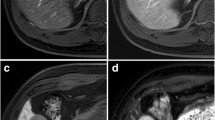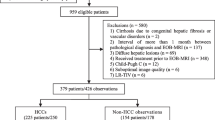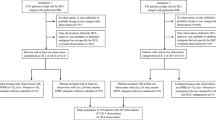Abstract
Objectives
To determine the strength of association with hepatocellular carcinoma (HCC) of each ancillary feature (AF) in LI-RADS version 2018, and to develop an appropriate strategy for applying AFs to improve the diagnosis of HCC ≤ 3 cm on gadoxetate-enhanced MRI.
Methods
A total of 385 nodules (283 HCCs, 18 non-HCC malignancies, 84 benign nodules) of ≤ 3 cm in 266 patients at risk for HCC who underwent gadoxetate-enhanced MRI in 2016 were retrospectively evaluated. Two radiologists independently evaluated the presence/absence of AFs, and assigned a LI-RADS category to each nodule. Diagnostic odds ratio (DOR) of each AF was assessed. To improve the diagnostic performance for HCC, various criteria were developed based on the number of AFs favoring malignancy in general or HCC in particular. Generalized estimating equation models were used to compare the diagnostic performance of each criterion with that of the major features (MFs) only.
Result
All AFs favoring HCC in particular and malignancy in general were more common in the HCC group than in the non-HCC group. Of these AFs, hepatobiliary-phase hypointensity had the strongest association with HCC (DOR, 21.82; 95% confidence interval, 5.59–85.20). When we applied AFs in addition to MFs, the new criterion (with a number of AFs ≥ 4) had significantly higher sensitivity (80.6% vs. 70.0%; p < 0.001) than MFs only, without significant lower specificity (85.3% vs. 90.2%; p = 0.060).
Conclusions
The AFs varied in the strengths of association with HCC. More strict application of AFs (AFs ≥ 4) in LR-3 may improve the diagnostic performance for probable HCC ≤ 3 cm.
Key Points
• The ancillary features (AFs) in the Liver Imaging Reporting and Data System version 2018 showed variable frequencies of occurrence and strengths of association with hepatocellular carcinoma (HCC).
• Of the various AFs, hepatobiliary-phase hypointensity had the highest frequency and strongest association with HCC on gadoxetate disodium–enhanced MRI.
• When applying AFs in addition to major features, a criterion of four or more AFs significantly increased the sensitivity for diagnosing HCC, without a significantly decreased specificity, especially in LR-3 observations.


Similar content being viewed by others
Abbreviations
- AASLD:
-
American Association for the Study of Liver Diseases
- AF:
-
Ancillary feature
- DOR:
-
Diagnostic odds ratio
- HCC:
-
Hepatocellular carcinoma
- LI-RADS:
-
Liver Imaging Reporting and Data System
- MF:
-
Major feature
- MRI:
-
Magnetic resonance imaging
- RFA:
-
Radiofrequency ablation
- TACE:
-
Transcatheter arterial chemoembolization
References
Mitchell DG, Bruix J, Sherman M, Sirlin CB (2015) LI-RADS (Liver Imaging Reporting and Data System): summary, discussion, and consensus of the LI-RADS Management Working Group and future directions. Hepatology 61:1056–1065
American College of Radiology CT/MRI LI-RADS v2018. Available via https://www.acr.org/Clinical-Resources/Reporting-and-Data-Systems/LI-RADS/CT-MRI-LI-RADS-v2018. Accessed May 27, 2019
Marrero JA, Kulik LM, Sirlin CB et al (2018) Diagnosis, staging, and management of hepatocellular carcinoma: 2018 Practice Guidance by the American Association for the Study of Liver Diseases. Hepatology 68:723–750
Tang A, Bashir MR, Corwin MT et al (2018) Evidence supporting LI-RADS major features for CT- and MR imaging-based diagnosis of hepatocellular carcinoma: a systematic review. Radiology 286:29–48
Cerny M, Bergeron C, Billiard JS et al (2018) LI-RADS for MR imaging diagnosis of hepatocellular carcinoma: performance of major and ancillary features. Radiology 288:118–128
Chernyak V, Tang A, Flusberg M et al (2018) LI-RADS® ancillary features on CT and MRI. Abdom Radiol (NY) 43:82–100
Choi SH, Byun JH, Kim SY et al (2016) Liver Imaging Reporting and Data System v2014 with gadoxetate disodium-enhanced magnetic resonance imaging: validation of LI-RADS category 4 and 5 criteria. Invest Radiol 51:483–490
Choi SH, Byun JH, Lim YS et al (2018) Liver Imaging Reporting and Data System: patient outcomes for category 4 and 5 nodules. Radiology 287:515–524
Joo I, Lee JM, Lee DH, Ahn SJ, Lee ES, Han JK (2017) Liver Imaging Reporting and Data System v2014 categorization of hepatocellular carcinoma on gadoxetic acid-enhanced MRI: comparison with multiphasic multidetector computed tomography. J Magn Reson Imaging 45:731–740
Bland JM (2004) Cluster randomised trials in the medical literature: two bibliometric surveys. BMC Med Res Methodol 4:21
Feinstein AR, Cicchetti DV (1990) High agreement but low kappa: I. the problems of two paradoxes. J Clin Epidemiol 43:543–549
Fraum TJ, Tsai R, Rohe E et al (2018) Differentiation of hepatocellular carcinoma from other hepatic malignancies in patients at risk: diagnostic performance of the Liver Imaging Reporting and Data System version 2014. Radiology 286:158–172
Cortis K, Liotta R, Miraglia R, Caruso S, Tuzzolino F, Luca A (2016) Incorporating the hepatobiliary phase of gadobenate dimeglumine-enhanced MRI in the diagnosis of hepatocellular carcinoma: increasing the sensitivity without compromising specificity. Acta Radiol 57:923–931
Lee MH, Kim SH, Park MJ, Park CK, Rhim H (2011) Gadoxetic acid-enhanced hepatobiliary phase MRI and high-b-value diffusion-weighted imaging to distinguish well-differentiated hepatocellular carcinomas from benign nodules in patients with chronic liver disease. AJR Am J Roentgenol 197:W868–W875
Orlacchio A, Chegai F, Fabiano S et al (2016) Role of MRI with hepatospecific contrast agent in the identification and characterization of focal liver lesions: pathological correlation in explanted livers. Radiol Med 121:588–596
Min JH, Kim YK, Sinn DH et al (2018) Adding ancillary features to enhancement patterns of hepatocellular carcinoma on gadoxetic acid-enhanced magnetic resonance imaging improves diagnostic performance. Abdom Radiol (NY) 43:2309–2320
Ronot M, Fouque O, Esvan M, Lebigot J, Aube C, Vilgrain V (2018) Comparison of the accuracy of AASLD and LI-RADS criteria for the non-invasive diagnosis of HCC smaller than 3cm. J Hepatol 68:715–723
Kim YY, An C, Kim S, Kim MJ (2018) Diagnostic accuracy of prospective application of the Liver Imaging Reporting and Data System (LI-RADS) in gadoxetate-enhanced MRI. Eur Radiol 28:2038–2046
Min JH, Kim JM, Kim YK et al (2018) Prospective intraindividual comparison of magnetic resonance imaging with gadoxetic acid and extracellular contrast for diagnosis of hepatocellular carcinomas using the Liver Imaging Reporting and Data System. Hepatology 68:2254–2266
Joo I, Lee JM, Lee DH, Jeon JH, Han JK (2019) Retrospective validation of a new diagnostic criterion for hepatocellular carcinoma on gadoxetic acid-enhanced MRI: can hypointensity on the hepatobiliary phase be used as an alternative to washout with the aid of ancillary features? Eur Radiol 29:1724–1732
Funding
The authors state that this work has not received any funding.
Author information
Authors and Affiliations
Corresponding author
Ethics declarations
Guarantor
The scientific guarantor of this publication is Jae Ho Byun.
Conflict of interest
The authors of this manuscript declare no relationships with any companies whose products or services may be related to the subject matter of the article.
Statistics and biometry
No complex statistical methods were necessary for this paper
Informed consent
Written informed consent was waived by the Institutional Review Board because of the retrospective nature of the study.
Ethical approval
Institutional Review Board approval was obtained.
Study subjects or cohorts overlap
There was subject overlap with an original article in J Hepatol (doi: https://doi.org/10.1016/j.jhep.2019.05.005) entitled “Arterial Subtraction Images of Gadoxetate-Enhanced MRI Improve Diagnosis of Early-Stage Hepatocellular Carcinoma”.
Methodology
• Retrospective
• Diagnostic or prognostic study
• Performed at one institution
Additional information
Publisher’s note
Springer Nature remains neutral with regard to jurisdictional claims in published maps and institutional affiliations.
Electronic supplementary material
ESM 1
(DOCX 50 kb)
Rights and permissions
About this article
Cite this article
Kang, J.H., Choi, S.H., Byun, J.H. et al. Ancillary features in the Liver Imaging Reporting and Data System: how to improve diagnosis of hepatocellular carcinoma ≤ 3 cm on magnetic resonance imaging. Eur Radiol 30, 2881–2889 (2020). https://doi.org/10.1007/s00330-019-06645-3
Received:
Revised:
Accepted:
Published:
Issue Date:
DOI: https://doi.org/10.1007/s00330-019-06645-3




